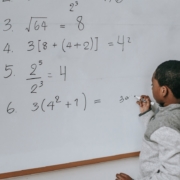Lesson Title:Understanding Units of Measurement
Grade Level: 6th
Duration: 45 minutes
Lesson Objectives:
1. Students will be able to identify and convert between different units of measurement, such as inches, feet, and yards.
2. Students will be able to use a ruler or tape measure to accurately measure length.
3. Students will be able to solve word problems involving units of measurement.
Materials:
Rulers or tape measures for each student
Word problems worksheet (attached)
Chart of common units of measurement (attached)
Introduction (5 minutes):
Begin the lesson by asking the students if they have ever measured something before. Ask them what tools they have used to measure and what units of measurement they have used. Write their responses on the board.
Direct Instruction (15 minutes):
Explain to the students that there are many different units of measurement that we use in everyday life. Show the chart of common units of measurement and go over the different units and what they are used to measure (length, weight, volume, etc.).
Next, demonstrate how to use a ruler or tape measure to measure length. Show the students how to read the measurements on the ruler and explain the difference between inches, feet, and yards.
Guided Practice (15 minutes):
Pass out the rulers or tape measures to each student and have them practice measuring different objects in the classroom. As they measure, have them record their measurements on a sheet of paper.
After students have had a chance to practice measuring, give them a word problems worksheet to work on. These problems will involve using units of measurement to solve real-world problems. Walk around and help students as needed.
Independent Practice (10 minutes):
Give students time to finish the worksheet on their own. Collect the worksheets and use them to assess student understanding.
Closure (5 minutes):
Review the main points of the lesson with the students. Ask them to share something they learned during the lesson. Remind them that understanding units of measurement is an important skill that they will use throughout their lives.
Assessment:
Observation of students using rulers or tape measures
Completed word problem worksheet
Class discussion and participation in class activities
Note: The above is a basic lesson plan, you can add more interactive activities and games to make the learning more fun and engaging for the students.










